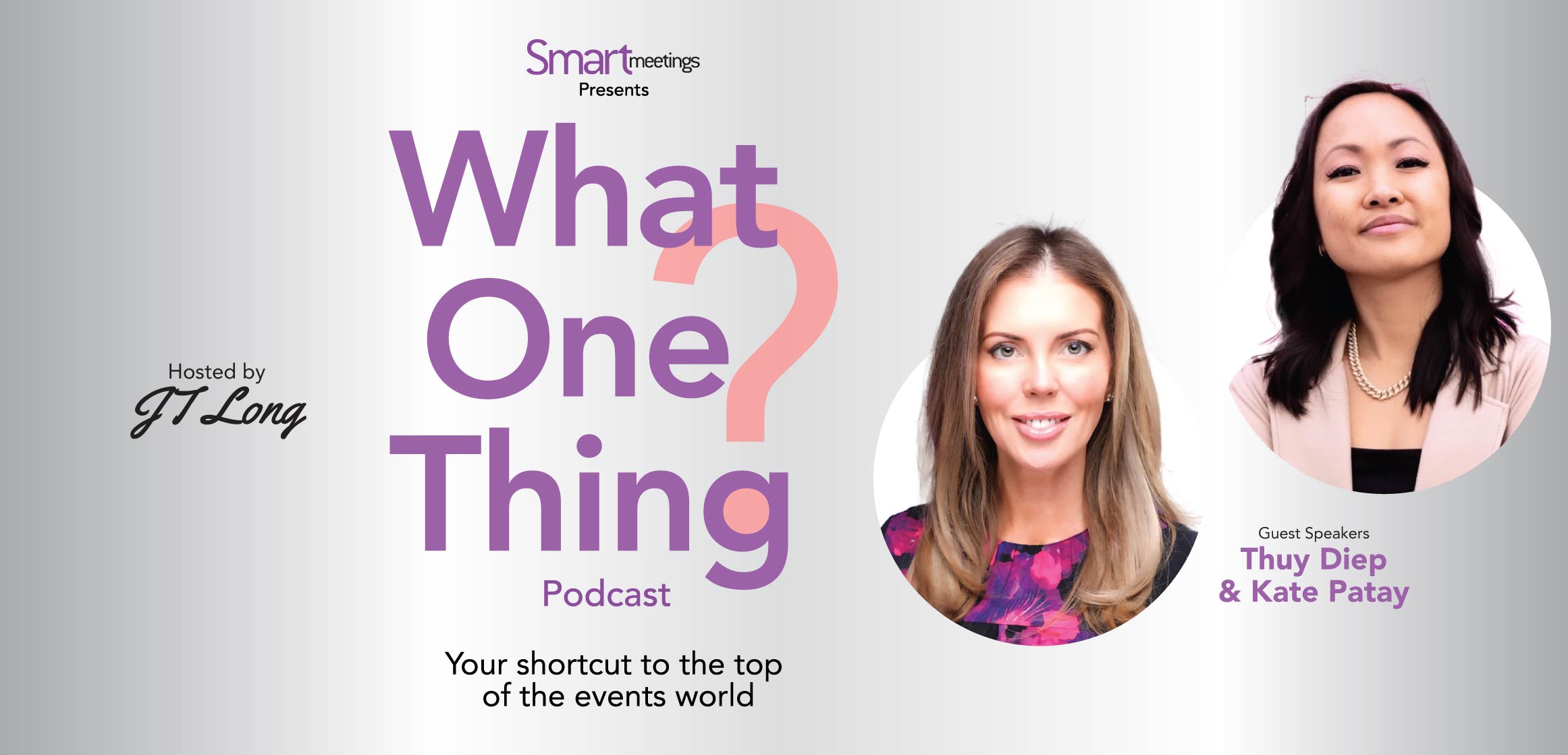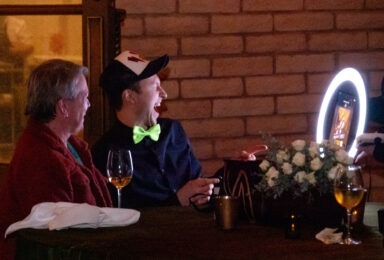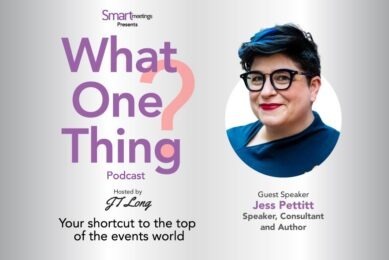How planners can foster deeper connections
On this episode of What One Thing?, JT Long, vice president and content director of Smart Meetings, sits down with Kate Patay, vice president of global engagement for Terramar, and Thuy Diep, senior meeting planner of CWT Meetings & Events, to discuss the art of building meaningful connections.
Listen in as they explore the differences between transactional and relational encounters.
Patay and Diep share personal stories that highlight the power of empathy, storytelling, and making personal connections.
This episode is a must-listen for anyone looking to cultivate more authentic and fulfilling relationships, both personally and professionally.
Editor’s note: This episode of What One Thing? was transcribed by Otter.ai and edited lightly.
JT Long Welcome back to What One Thing? I’m JT Long, vice president and content director here at Smart Meetings, and this is a special IMEX edition. I’ve brought in some relationship experts to talk about the right way, the wrong way, and fresh ways to meet new people and build meaningful relationships.
Most of you probably know “Auntie Kate.” Kate is the vice president of global engagement at Terramar DMC. They’re a wonderful partner of Smart Meetings, and we appreciate them so much. She’s also the Director of the Search Foundation Board and does amazing work helping planners in need. Welcome, Kate.
Kate Patay Thank you for having me! And I love that you used “Auntie Kate”—my favorite title of all!
JL Thuy Diep is the Senior Meeting Planner at CWT Meetings and Events. Let me tell you a secret about Thuy and Kate: Back when the pandemic first started, around late March of 2020, I had them both on a webinar that became one of our highest-attended ever. We were worried because we went over our 1,000-person limit—1,600 people registered, and it was about to cut people off. Thuy is always someone I invite when I want important, meaningful conversations. Yay! Hello, hello.
Thuy Diep Hello! So good to be here.
JL We were at a conference in Las Vegas about a month ago, chatting during a culinary experience at Area 15, as one does. We discussed the difference between relational and transactional encounters. I always like to define my terms, right? It’s not necessarily good or bad to be relational or transactional—there’s a place for both. Personally, at the grocery store, I’d prefer it to be transactional. I don’t need the checkout person to comment on every item I buy unless they want to see pictures of my grandbabies! But sometimes, you want a deeper conversation, a deeper relationship. Kate, can you kick us off by defining the difference between relational and transactional encounters?
KP Sure! A relationship-driven interaction is long-term—you’re in it for the long haul. That’s really what our industry is about. It’s not just a one-time, quid-pro-quo transaction. I like to be transparent. I even joke about which “hat” I’m wearing in a conversation—whether I’m representing TerraMar, the Search Foundation, or just being a friend. Being clear about that cuts down on miscommunication and unmet expectations.
TD Absolutely. Transactional encounters are focused—you have a goal in mind, whether it’s gaining knowledge or business. I did some research, and the opposite of transactional is transformational, which is similar to relational. When I hopped on this recording, I was so excited to see both Kate and JT because we have deeper, long-term connections. Having a human approach allows conversations to continue at future Smart Meetings conferences and beyond.
JL Exactly. Being transparent is important. I don’t mind transactional relationships if they’re clear about it. What bothers me is when someone pretends it’s a relationship but is only interested in a transaction. Just be honest!
KP Yes! It’s all about transparency. If you expect something from a conversation, you need to communicate that. Otherwise, you’ll be disappointed because no one’s going to meet expectations they don’t know exist.
TD Absolutely. To build on that, it comes down to being genuine. Kate once described me as “genuine” rather than witty, and I’m honored by that. When you show up authentically, it creates a safe space for deeper connections.
KP That reminds me of a photo I use when presenting—it’s of a stereotypical used car salesman. There’s a person in our industry who’s like that; everyone hides when they see him because he’s all about the transaction, in your face, all the time. That’s not what I want people to feel about me. If people are hiding from me, I know I’m doing something wrong.
JL Authenticity is important on both sides. Some people may have anxiety about networking, but I tend to take a “golden retriever” approach—bounding right up to people, assuming they want to talk! But I understand that not everyone is like that. Everyone’s authentic self is different, and we need to meet them where they are.
KP It does. I see you do that often, JT, especially at our in-person events. You can light up a room, but you’re also good at standing to the side and meeting people on their level. That’s a special quality.
TD It’s about approaching with curiosity. When you’re curious about someone, you naturally want to dive deeper. That curiosity helps create genuine connections.
KP You can always tell when someone isn’t interested in engaging. If they’re looking around the room or seem distracted, I might ask if they’re looking for someone. Or, if it’s Thuy, I might say, “Girl, you’re distracted. Go find who you need to find.” You don’t need to be stuck in a conversation where neither of you is fully engaged.
JL Yes, and you can gracefully step out of a conversation. Excuse yourself to find someone else or say you need to go to the restroom—never a lie!
TD Haha, yes, bathroom buddy, I got you!
JL When preparing for cocktail parties at IMEX, we often invite Debra Fine, who teaches about the fine art of small talk. She encourages open-ended questions that allow people to choose what to share. Asking, “Catch me up on your life,” lets them pick where to start. Do you have any icebreaker tips?
TD I love asking, “What’s been on your mind lately?” It’s open enough that they can steer the conversation.
KP I’ve stolen a few of your conversation starters, Thuy. I also love connecting people who might not know each other. If I see two people who would get along, I’ll introduce them with a few interesting details about each, and let them take it from there.
JLI love that. We focus a lot on finding commonalities at Smart Meetings. You can always compliment someone’s shoes—it’s a great conversation starter!
KP Exactly. And when you introduce two people, share something personal about each. It helps break the ice and leads to deeper connections.
JL Yes, we’re all planners here, and we can help set attendees up for success. One idea is to connect first-time attendees with others, either virtually or in person. What are some fun ways planners can facilitate connections?
KP I’ve used badge ribbons that say “First-Time Attendee.” It’s a simple way to invite someone into a conversation.
TD When planning, I think about the personas of attendees. Introverts might benefit from interactive games or mind teasers that encourage engagement without forcing interaction. It creates those “collision moments” where connections happen naturally.
KP I once attended an event where everyone received the wrong name badge. We had to track down our correct badges, which led to some fun interactions. I’m still friends with the person I spent over an hour searching for!
JL I love that! It doesn’t need to be complicated—just something that helps people engage.
TD Yes, and as a planner, if you know what people are looking forward to at an event, you can make sure they have that experience. It’s all about setting them up for success.
KP Exactly. Surprise and delight them—it makes a huge difference.
JL Another great way to build relationships is by volunteering on boards. Thuy, how did you first get involved, and what’s that experience been like for you?
TD Volunteering on boards has been foundational to my success. I got involved with the Search Foundation through ILEA in Las Vegas, where Kate and I bonded. Volunteering helps you develop your skills, build connections, and give back to the industry.
KP I agree. I’ve served on many boards, and you get out of it what you put in. Volunteering builds your network and creates lasting connections. With the Search Foundation, I feel like it’s my way of giving back. We leave our egos at the door and focus on what’s best for the foundation. It’s incredibly rewarding.
JL Our industry is so interconnected. The people you volunteer with today could be the same people you work with tomorrow.
KP Absolutely. You never know who you’ll work with or for in the future. Always keep that in mind.
JL Speaking of connections, someone once told me about “Pac-Manning” at networking events. You leave a little gap in your circle of people, like Pac-Man’s open mouth, so others can join in. It’s a simple way to make sure new people feel welcome.
KP I love that idea. It’s so important to make room for others, especially at big events like IMEX.
JL This is called What One Thing?, so we like to end by asking: What one thing made the biggest difference in your career when it comes to relationships?
KP I think I had to learn to admit when I’m wrong and fix it immediately. That’s not always an easy thing to do, whether in business or life, but it’s crucial. If you’ve missed a step, you have to take the necessary steps to correct it. Your reputation depends on how you follow through on something that might not have gone as smoothly as it could have. I believe that the way you handle those situations—owning up to your mistakes and taking action to make things right—can actually strengthen your relationships. It’s about integrity.
TD For me, it’s about practicing active listening. As I get wiser through the years, I’ve found that being fully present and genuinely listening to others has really defined my character. It allows people to open up and share their stories. That curiosity and willingness to listen is what helps me connect with people on a deeper level. I truly can’t do my role without the collaboration and synergy of others. Whether it’s a simple conversation at a networking event or a heart-to-heart with a friend, being an active listener has been the foundation of my relationships.
JL I love both of those responses. I’d have to say, I agree with Thuy—if you approach people with empathy and curiosity, wanting to genuinely help them succeed, things can’t go wrong. It’s about being authentic and caring about the people you meet, beyond just the business aspect.
KP That’s a great note to end on. I’ve loved this conversation and look forward to many more, both at IMEX and beyond.
TD Same here. Thank you both for the wonderful chat. I’ll see you at the next event!
JL Thank you to both of you for taking the time to share your insights on building relationships. And thank you to our listeners for tuning in. I hope this conversation has provided some helpful tips for you. This has been What One Thing?, a Smart Meetings podcast made just for you.




